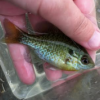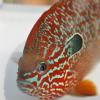I have a 65g tank, moderately planted if you count duckweed, not too heavily decorated. It currently holds 9 blacktail shiners (numbers dropping, the big longear keeps eating the smallest ones) and 6 longear sunfish. One of the longears is nearly adult, four of them are about 3", and one is about 2". I caught the big guy about two weeks ago, and I've had the smaller ones for a bit over a week.
When I caught the little guys, they were tinted nicely orange with white flecks, and a couple of them were very orange. They stayed like that for the entire transport, then faded to a more typical sunfish color of greyish-silver. A couple have a slight bit of orange, but that's it. They don't seem stressed or upset, they approach the glass to look at me and they're usually out in the open.
Things that could be responsible:
Perhaps they're still stressed from capture and they need more time.
Maybe they need more hiding spots? The tank is pretty sparse. It's been redecorated, and I'm trying to mimic the type of area sunnies inhabit in my local river. There aren't many plants, though the ground is covered in long algae in spots. The only real hiding spots (unless you're a teeny baby fish) are areas around large rocks, and there aren't many rocks. The area I was fishing from had one large boulder, a couple of small ones, and an area where the reeds overhang and hide the water. I have duckweed to suck the nitrates up and give some shade, and I have a twisty piece of wood and a glass jar to offer hiding places.
I've attached a picture of the tank so you can see what I have. That's most of the tank, excluding the edges. The wood has slots for about three different sunfish, one on each side. The big sunny normally takes up one side, which leaves two or three spaces for the smaller ones to bolt into, and the jar can hold one or two. They can also tuck up behind the jar. The little guy has a small cave-thing under some twigs and plants on the left. They don't squabble over hiding spots, not that I can see.
I have a football-sized bottle outside in a bucket to grow algae. There's a big hole in the side, and once I take a grinder to the edges, it can go into the tank to be another hiding spot. I plan to put it in the corner.
Should I get another piece of twisty wood or something?
Could aggression be the issue? The big sunny was a problem at first, but then I did a big water change and moved some stuff around. There was some squabbling for the rest of the day, but after that, everybody calmed down. The big guy lunges at anybody in his space, but he doesn't hurt them even if he catches them, he's not trying to bite. He just swims at them and chases them off, then goes back to his spot and sits.
The little guys lunge at each other when they get too close together. The aggression seems to be fairly evenly distributed, no one fish looks like it's being picked on more than the others. The baby spends most of his time slinking around the edges, but he's growing fast and becoming more bold as his size starts to catch up.
There are a couple of torn fins from the initial territory squabbling, but no damage other than that.
This is about the level of aggression I was seeing in the river, so I don't think this is the issue, but it's worth mentioning.
Maybe it's the diet? I have some cichlid sticks, but only the big guy will eat them. The smaller ones will bite the sticks, but then spit them out. I think I'm going to try breaking the sticks into pieces and soaking them with some shrimp.
I've been feeding the little guys bloodworms, table shrimp, and the occasional bit of mixed frozen food. I think I have some mysis shrimp somewhere, but the big guy was easy to wean onto dry food and I was hoping the little guys would be similar. I didn't intend to depend on the frozen food.
What would you suggest I offer? I could get some frozen krill or mysis, or maybe some mussels. If anybody has suggestions for a good color-boosting food, I'll take them, but I have a restriction. Due to severe allergies in the family, nothing with gluten is allowed in the house. No wheat, barley, oats, or rye. Took me a while to find these cichlid sticks. They're from yourfishstuff.com.













